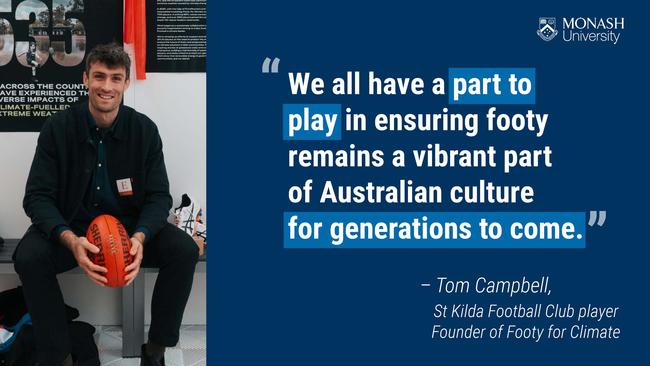The AFL fights to stay cool as climate change heats up the game
The AFL faces challenges on and off the field as climate change fuels extreme weather. Players and fans are stepping up to protect the future of the game.

HyperLocal
Don't miss out on the headlines from HyperLocal. Followed categories will be added to My News.
The Australian Football League (AFL) is a core part of Aussie culture and embraced by millions.
It's no surprise then that the AFL clocked over eight million attendees and around 141 million TV viewers last season alone.
But rising temperatures and more frequent extreme weather events threaten how our beloved Aussie passtime is played, watched, and celebrated.
If we zoom in from the grandstands to our own backyards, we see Wollongong is already experiencing these changes.
In fact, the hottest September day sits around 2.5C warmer than it was 50 years ago.

Footy for climate
A survey of the AFL Players Association had found that about 92 per cent of players were concerned about the impacts of climate change.
Tom Campbell, St Kilda Football Club player and co-founder of Footy for Climate, has seen firsthand the impact of climate change on the footy community during the Black Summer bushfires of 2019-2020.
"At that time we saw images of communities being devastated around our country, and this prompted me to have conversations about climate change with my teammates," he recalled.
Campbell emphasised the growing strain on local teams, noting, "around 535 community clubs have needed financial assistance because of damage from extreme weather since Black Summer."
"That's not just a number – that's real people and real communities being affected."
In response, Campbell co-founded Footy For Climate with Jasper Pittard as an organisation focused on inspiring climate action across the Australian football community, from the local to the elite level.
To address these challenges, Footy for Climate is championing renewable energy as a viable solution.
"We believe that transitioning to renewable energy is a powerful way for community clubs to reduce their carbon footprint," Campbell said.
Research shows that installing solar panels on Australia's major stadiums, and sporting headquarters could generate enough energy to supply clean power to around 3000 households each year.
"But it's not just about going green – it's about making these clubs more resilient and sparking important conversations about climate action across the sporting community." Campbell said.
Leadership within the AFL is crucial for driving this change, and Campbell highlighted the Richmond Football Club as a role model within the sporting community.
"Richmond has really stepped up with their Environmental Sustainability Action Plan," he explained.
"They've committed to halving their emissions by 2030 and reaching net zero by 2040 – this is the kind of leadership we need to see across the AFL."
Kicking goals for the future
As footy faces the uphill battle against a changing climate, players and fans will be crucial for winning the fight.
There are always opportunities to make a positive impact, no matter how small and we can help by supporting sustainable practices and reducing our carbon footprint.
Simple actions, like taking public transport to games or encouraging your club to invest in renewable energy, can make a difference.
"We all have a part to play in ensuring footy remains a vibrant part of Australian culture for generations to come." Campbell noted.
Did you know?

Want more information on how your climate is changing? Check out the last article in this series.
Mandeep Singh is a Senior Project Officer at the Monash Climate Change Communication Research Hub.
This column is part of a collaboration between Monash University and News Corp to deliver hyperlocal weather and climate information.


